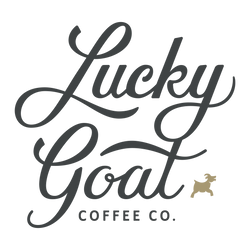How to Taste Coffee Like a Roastmaster
Have you gotten more into coffee recently and wondered how roasters assign tasting notes to certain Single Origin coffees? Have you wanted to learn how best to distinguish coffees in a lineup? Have you desired a bit of insight into the complicated world of sensory analysis of coffee? We’re here to give you an introduction to coffee tasting, and what it looks like for our professionals here at Lucky Goat.
While similar to the wine industry, tastings in coffee can be even more complex. The olfactory and gustatory analysis of coffee is one of the most important skills that a roaster, quality assurance professional, or barista can develop—and just plain fun for the average coffee consumer. However, it’s quite the endeavor to embark on, especially without working in the coffee industry, an arena where you can live and breathe these practices. We will break down the process for you and get you on your way to tasting coffee like a professional.
Cupping
The gold standard process for the sensory evaluation of coffee is called a cupping. This is a strict brewing protocol with specific parameters for the coffee and rules for the participants. The goal of this process is to eliminate all variables of brewing that may produce an inconsistent cup of coffee. Everything from grind size to water temperature is controlled in this protocol, so that anyone can follow the guidelines and get the same result for a given coffee. This mainly helps cuppers to grade and evaluate coffees consistently and fairly and gives us a side-by-side comparison of coffees in front of us. While there are several rules to follow, it’s pretty simple once you become familiar.
Participant Rules
All the cupping rules ensure there isn’t extra interference with the sensory evaluation of the coffee. Any extra smells, tastes, or biases are not allowed in the cupping room. Participants should not wear any perfume or cologne as it affects the way you perceive the smell of your coffee. Participants shouldn’t be undercaffeinated, overcaffeinated, fasted, or just eaten, as these states will affect how good the coffee tastes to you. There should also be no talking, disruptions, or sharing of opinions. Your thoughts on the coffee should be entirely your own, and you should be focused during the cupping to maximize your perceptions.
The Brewing Protocol
The recipe for a cupping starts with 8.5 g of medium-coarse ground coffee. Your coffee should look like a coarse sea salt. You generally want at least 3 samples of each coffee to ensure the samples are uniform with one another. Often times, we use cupping bowls, which are sized well for the amount of water we are adding, but you can use any 150-200 ml cup as well. The brew calls for 150ml of 200-degree water. It’s important to make sure coffee is ground no sooner than 15 minutes before the evaluation begins, as the aromatic compounds will quickly dissipate once the coffee is ground.
The Process
Each person should start with a score sheet or cupping form that breaks down into sections evaluating smells and tastes. Before any water is added, the evaluators first go cup-to-cup to evaluate the smell of the dry grinds of coffee, often called the fragrance. They will jostle the grinds in the cup, make quick inhalations right over the grinds, and make notes of whatever they are smelling. Then the water is added, a timer is started, and a crust of grinds floats to the top of the cup, trapping lots of aroma underneath. Keeping a careful eye on the stopwatch, the cuppers will then begin evaluating the aroma, or the smell of the wet brewing coffee. At the three-minute mark, it is time to “break the crust”. Using a spoon, they will push the crust of grinds lying on top of the coffee aside so that they can smell all of the aroma that lies underneath. After carefully notating their sensory experiences for each coffee, it is time to start tasting.
The coffee will be slurped and tasted several times as the coffee cools down. When the heat starts to dissipate, more and more flavors will become detectable, so it’s important to taste coffee at each of its temperatures. When you slurp your coffee, you should do so with a fast burst of air in, so that you aerate the coffee as you sip it (bringing out its flavor) and spray it over the whole surface of your tongue. You want to be sure that all of the flavor-detecting taste buds are exposed to the coffee to give you the most complete experience with it. You should be evaluating tastes like bitterness, acidity, sweetness, aftertaste, and body, and taking detailed notes to compare with the other cuppers in the room.
So, there you have it! An introduction to the process that coffee professionals use to evaluate coffee. Cupping takes lots of practice, so we recommend tasting as many coffees as you can, and having a coffee tasting wheel close by when you first start so that you can match up what you’re tasting with common notes. Next time you’re in one of our cafes, grab a new bag of Single Origin coffee and see what tasting notes you detect!










